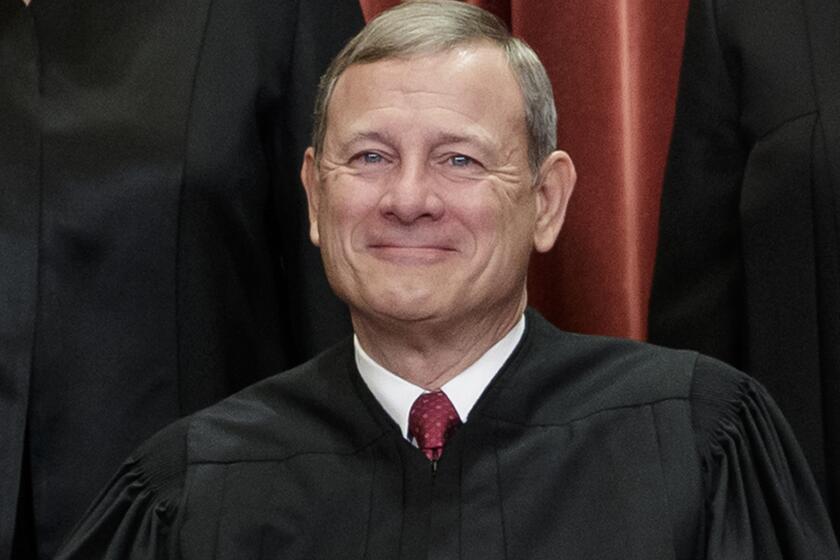Intervention by ‘Outsiders’ Gets Alaskans Hot Under the Collar : A proposed wolf kill is writing a new chapter in the battle over who will manage the state’s natural resources.
- Share via
FAIRBANKS, Alaska — In their own rendition of the age-old wheeze about there being two kinds of people in the world, Alaskans tend to make the split this way: There are Alaskans--God love their hardy souls--and there are the “Outsiders.”
For the most part, this is a carefree tradition. Visit Alaska and people will try to sell you, ha ha, moose droppings glued onto souvenir swizzle sticks. But they remain respectful enough to capitalize the description “Outsiders” in their newspaper columns and polite correspondence.
Which was fine as long as Outsiders remained docile. But some of them haven’t been, and Alaskans have grown plenty edgy about it this winter.
There was, for example, the reaction from Outsiders when the state said it wanted to kill some of its wild wolves, thus increasing its moose and caribou herds, which in turn could be shot by Alaska hunters. State officials might as well have suggested setting off an A-bomb over a national forest to help Alaskans down firewood, so popular was the idea in the Lower 48.
To their shock, state officials found the furor was so great that they felt obligated to postpone the wolf kill pending further study. In the process, many Alaskans felt their grip weaken on one of their most prideful prerogatives, the management of Alaska’s wild animals and lands.
Some Alaska leaders said they believe that the episode has altered the terms of the debate over a broad, basic question: Who will chart the future for America’s last unspoiled wilderness? And for what end? Will it be the national government, acting for all Americans, or Alaska on behalf of Alaskans?
Because federal taxpayers hold deed to 60% of Alaska, this kind of us-versus-them friction has added heat to public policy debates in Alaska before. But not with the intensity of the wolf-kill argument, and certainly not with the current split between some of the state’s mighty business and development interests.
Alaska has spent years pursuing expansion of its basic commercial industries: tourism, logging, mining, fishing and energy production. Generally, the leading politicians and institutions of Alaska seemed in agreement that expansion in all these areas was compatible and in the state’s best interest.
But the plan to kill 300 to 500 wolves each year for five years did something that nothing else has: The $1.1-billion travel business, Alaska’s No. 3 employer after government and seafood, suddenly broke ranks and said it may no longer share the same vision of Alaska’s future as those in the natural-resource industries.
Not only that, tourism leaders demanded a say in wilderness-management decisions from now on. Why? Because thousands of Americans heard of the wolf kill and wrote, telephoned and faxed their protests, and many of them promised not to travel to Alaska. Animal rights groups followed with an organized call for a tourism boycott.
Gov. Walter J. Hickel said his office received calls and correspondence from 20,000 Americans, virtually all with the same point of view.
Don’t kill the wolves, the Outsiders pleaded. Don’t play God and favor one animal over another. Can’t one place be left wild? We’re going to New Zealand, bye.
Hickel responded by suspending the wolf kill for 1993. State game officials will meet again in June, hoping the furor will have cooled. At that time, the whole idea of what Alaskans call “predator control” will be voted on again.
At a recent state-sponsored “wolf summit” here, Tom Garrett, a backcountry guide and member of the Alaska Wilderness Recreation and Tourism Assn. explained the impact of Outsider protests on the travel industry:
“Whenever people talk about developing or exporting Alaska’s resources, they talk only about mining, oil and gas, timber and fisheries. Everyone involved with managing Alaska’s resources needs to realize that the resources they are managing are the critical elements of Alaska’s tourism industry.
“And altering the resource, whether it is by cutting trees, hunting the bears, mining the land or shooting the wolves, will--I don’t say might--will have some impact on tourism.”
The big steamship and tour-bus companies joined in the outcry.
Environmentalists called it a watershed in modern Alaska.
“What you see happening is the tourism business coming to life as never before as players in the management of natural resources. And the reason is simple: It has a direct bearing on the success of the industry,” said Allen E. Smith, Alaska regional director of the Wilderness Society.
But countervailing pressures within the state--pressures to thin out the wolf packs and to develop the wilderness for the sake of Alaskans--run powerful and deep. And protests from wolf fanciers, environmentalists and the tourism industry seemed only to fuel this rage.
Indeed, the dispute highlights what is one of the greatest cultural gulfs in America--that between space-squeezed urbanites in the Lower 48 and sub-Arctic sourdoughs and natives who live close to the land. So far, it is worth noting, these two divergent sides have almost no sympathy, patience or understanding for each other.
“We have the right to care for this land according to our knowledge of the north. That right must not be trampled, or there will be trouble,” Hickel told Alaskans recently.
During the recent wolf summit called to bring all points of view to the surface, sourdough Alaskans put on a colorful and provocative display of their feelings. “Feed the Wolves Lead,” read one of a hundred or more protest signs. “Quick, Take My Kids Away Before I Teach Them To Hunt!” said another.
In the sub-freezing cold, the protesters draped themselves in animal skins and at one point posed for pictures with a freshly slain wolf carcass, which they heaved around like a stuffed doll.
What sense does it make, they asked, for humans to be the top predator in the food chain and not tilt the balance in their own favor? Besides, the wolf has never been listed as threatened or endangered in Alaska. If the state yields to Outsiders on this, what is next?
From these Alaskans, the message seemed to be the same: We’ll manage Alaska our way, thanks, and the rest of you can butt out.
“We don’t tell them how to run their riots down there. Why are they sticking their noses into how to run our state?” demanded fur trapper Neil Greenfield.
At the Athabascan Indian community of Minto, located northwest of Fairbanks, villager Ken Charlie summed up the rural Alaskan disdain for Outsiders and all their passions about wild wolves. “It’s a bunch of crock. . . . I have a right to get mad at them. I wish the state of Alaska had told them (tourists): ‘Stay where you are. We don’t need you. We’re going to live the way we live.’ ”
Both sides seem to agree that the friction will grow hotter under the pressure of two other forces in Alaska: population growth and the need to compensate for the loss of money now that the Prudhoe Bay oil fields have passed their peak.
Many economic prospects for the future are likely to run into conflicts with tourism and the preservation mentality of Outsiders. Among these are further Arctic oil-drilling, mining--including in riverbeds designated by the federal government as “wild” and “scenic”--timber harvesting and game ranching.
Some Alaska business leaders said they believe that the differences in perspective can be reconciled with advertising and public relations campaigns to “correct” misconceptions about Alaska. “We will need to mitigate the damage,” explained Fairbanks car dealer and wolf-control supporter Ralph Seekins.
But public relations may not be enough to convince Americans in the Lower 48 that growth is compatible with their vision of a truly wild Alaska. David R. Cline, regional vice president for the National Audubon Society, said: “The national interests here have to be protected by the American people because it’s been proven over and over again (that) Alaskans are going to put their interests first.”
More to Read
Sign up for Essential California
The most important California stories and recommendations in your inbox every morning.
You may occasionally receive promotional content from the Los Angeles Times.










